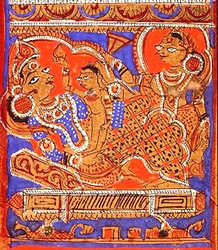 |
The
Birth of Mahavira |
The Jain festival (parva) of Paryushana originates from the practice adopted by itinerant monks of staying in one place during the Indian monsoon. Paryushana means “to stay closer” and is taken symbolically as a period when it is possible to re-establish a closeness with the soul. It is the holiest time of the year for Jains, consisting of 8-10* days of meditation, fasting and prayer and ending with a ceremony of atonement meant to prepare the believer for emergence into the world in a state of spiritual and moral refinement.
In one of the festival’s more colourful rituals, the story is told of the conception of Lord Mahavira, the man considered to have shaped the Jain religion over 2,600 years ago. The scriptures tell how Mahavira’s mother had a series of dreams at the time of his conception, each one prophetic of a quality the future leader would display. Silver figures representing these dreams and symbolic of virtues such as strength, courage and wisdom are paraded through the congregation and up to the altar; the money families bid for the privilege of carrying these symbols is used to support the community.
The
auction and presentation of these ‘dreams’ is also a way of
teaching Mahavira’s story to the next generation. Toward the end
of the ceremony a silver coconut is placed in a swing to represent the
appearance of Mahavira in the womb; each member of the congregation takes
a turn at rocking the swing, a symbol of nurturing the new life to come.